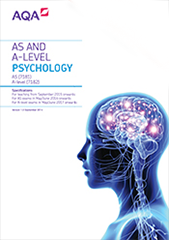3.2 Psychology in context
Students will be expected to:
- demonstrate knowledge and understanding of psychological concepts, theories, research studies, research methods and ethical issues in relation to the specified Paper 2 content
- apply psychological knowledge and understanding of the specified Paper 2 content in a range of contexts
- analyse, interpret and evaluate psychological concepts, theories, research studies and research methods in relation to the specified Paper 2 content
- evaluate therapies and treatments including in terms of their appropriateness and effectiveness.
Knowledge and understanding of research methods, practical research skills and mathematical skills (see Annex: Mathematical requirements and exemplification) will be assessed in Paper 2. These skills should be developed through study of the specification content and through ethical practical research activities, involving:
- designing research
- conducting research
- analysing and interpreting data.
In carrying out practical research activities, students will manage associated risks and use information and communication technology (ICT).
Approaches in Psychology
Origins of Psychology: Wundt, introspection and the emergence of Psychology as a science.
The basic assumptions of the following approaches:
- Learning approaches: i) the behaviourist approach, including classical conditioning and Pavlov’s research, operant conditioning, types of reinforcement and Skinner’s research; ii) social learning theory including imitation, identification, modelling, vicarious reinforcement, the role of mediational processes and Bandura’s research.
- The cognitive approach: the study of internal mental processes, the role of schema, the use of theoretical and computer models to explain and make inferences about mental processes. The emergence of cognitive neuroscience.
- The biological approach: the influence of genes, biological structures and neurochemistry on behaviour. Genotype and phenotype, genetic basis of behaviour, evolution and behaviour.
Biopsychology
- The divisions of the nervous system: central and peripheral (somatic and autonomic).
- The structure and function of sensory, relay and motor neurons. The process of synaptic transmission, including reference to neurotransmitters, excitation and inhibition.
- The function of the endocrine system: glands and hormones.
- The fight or flight response including the role of adrenaline.
Psychopathology
- Definitions of abnormality, including deviation from social norms, failure to function adequately, statistical infrequency and deviation from ideal mental health.
- The behavioural, emotional and cognitive characteristics of phobias, depression and obsessive-compulsive disorder (OCD).
- The behavioural approach to explaining and treating phobias: the two-process model, including classical and operant conditioning; systematic desensitisation, including relaxation and use of hierarchy; flooding.
- The cognitive approach to explaining and treating depression: Beck’s negative triad and Ellis’s ABC model; cognitive behaviour therapy (CBT), including challenging irrational thoughts.
- The biological approach to explaining and treating OCD: genetic and neural explanations; drug therapy.
Research methods
Students should demonstrate knowledge and understanding of the following research methods, scientific processes and techniques of data handling and analysis, be familiar with their use and be aware of their strengths and limitations:
- Experimental method. Types of experiment, laboratory and field experiments; natural and quasi-experiments.
- Observational techniques. Types of observation: naturalistic and controlled observation; covert and overt observation; participant and non-participant observation.
- Self-report techniques. Questionnaires; interviews, structured and unstructured.
- Correlations. Analysis of the relationship between co-variables. The difference between correlations and experiments.
Scientific processes
- Aims: stating aims, the difference between aims and hypotheses.
- Hypotheses: directional and non-directional.
- Sampling: the difference between population and sample; sampling techniques including: random, systematic, stratified, opportunity and volunteer; implications of sampling techniques, including bias and generalisation.
- Pilot studies and the aims of piloting.
- Experimental designs: repeated measures, independent groups, matched pairs.
- Observational design: behavioural categories; event sampling; time sampling.
- Questionnaire construction, including use of open and closed questions; design of interviews.
- Variables: manipulation and control of variables, including independent, dependent, extraneous, confounding; operationalisation of variables.
- Control: random allocation and counterbalancing, randomisation and standardisation.
- Demand characteristics and investigator effects.
- Ethics, including the role of the British Psychological Society’s code of ethics; ethical issues in the design and conduct of psychological studies; dealing with ethical issues in research.
- The role of peer review in the scientific process.
- The implications of psychological research for the economy.
Data handling and analysis
- Quantitative and qualitative data; the distinction between qualitative and quantitative data collection techniques.
- Primary and secondary data, including meta-analysis.
- Descriptive statistics: measures of central tendency – mean, median, mode; calculation of mean, median and mode; measures of dispersion; range and standard deviation; calculation of range; calculation of percentages; positive, negative and zero correlations.
- Presentation and display of quantitative data: graphs, tables, scattergrams, bar charts.
- Distributions: normal and skewed distributions; characteristics of normal and skewed distributions.
- Introduction to statistical testing; the sign test. When to use the sign test; calculation of the sign test.
